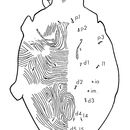en
names in breadcrumbs


Tydeidae is a family of acariform mites. As of 2016, it contained over 300 species in three subfamilies,[1] though more species have been discovered since then.[2]
These mites live in a wide range of habitats and there are predatory, fungivorous and scavenging species.
Tydeidae are soft-bodied mites with an idiosoma that is striated, reticulated or a combination of both. They have two bothridial setae. The chelicerae have fused bases, a movable digit that is relatively short and needle-like, and a fixed digit that is reduced. They may have two or three eyes, though some species are blind.[1]
Of the three subfamilies, Pretydeinae has no setae on the genu of legs II, III or IV, and the palptarsus has a triple eupathidium at the end. The other two subfamilies have one or two setae (Tydeinae) or three setae (Australotydeinae) on the genu of leg II, and the palptarsus ends in a double or triple eupathidium.[1]
Tydeids are among the most commonly encountered mites in arboreal habitats, including leaves, stems, tree trunks, canopy soils, sporocarps and nests.[3] They are also found in caves, soil, humus, litter, grass, straw, hay and stored products.[1][4]
Most tydeids are scavengers or fungivores, while some can feed on plants, pollen or animal prey.[1]
Various tydeid species are themselves preyed on by phytoseiid mites.[5]
Species in several genera have been found in beehives. The nature of their relationship with bees is uncertain.[4]
Some species of Tydeus are medically important: T. interruptus may be a reservoir for scrapie-like agents, while T. molestus causes itching and skin irritation in humans and domestic animals.[4]
Tydeus californicus and Lorryia formosa can damage citrus plants.[4] On the other hand, some tydeid species can benefit agriculture by suppressing (through their feeding) powdery mildew and downy mildew.[1]
Tydeidae includes three subfamilies with the following genera:[1]
It once also included subfamilies Edbakerellinae, Pronematinae, Triophtydeinae and Tydaeolinae. Edbakerellinae and Triophtydeinae have since been moved into family Triophtydeidae, while Pronematinae and Tydaeolinae have been moved into family Iolinidae.[6]
Tydeidae is a family of acariform mites. As of 2016, it contained over 300 species in three subfamilies, though more species have been discovered since then.
These mites live in a wide range of habitats and there are predatory, fungivorous and scavenging species.
Les Tydeidae sont une famille d'Acariens. Ce sont généralement des petits acariens avec des couleurs ternes. Le corps est mou, souvent avec des motifs complexes striés ou réticulés. Certaines espèces ont deux ou trois yeux bien que beaucoup en soient complètement dépourvus.
Ces acariens vivent dans un large éventail d'habitats et il y a des espèces prédatrices, fongivores et nécrophages.
Selon NCBI (26 nov. 2010)[1] :
Les Tydeidae sont une famille d'Acariens. Ce sont généralement des petits acariens avec des couleurs ternes. Le corps est mou, souvent avec des motifs complexes striés ou réticulés. Certaines espèces ont deux ou trois yeux bien que beaucoup en soient complètement dépourvus.
Ces acariens vivent dans un large éventail d'habitats et il y a des espèces prédatrices, fongivores et nécrophages.
Латинское название Tydeidae Kramer, 1877 ITIS 895676 NCBI 708320
Tydeidae (лат.) — семейство акариформных клещей (Prostigmata) из отряда Trombidiformes.
Встречаются повсеместно[1][2], большая часть видов в Западной Палеарктике (более 200 видов)[3].
Мелкие клещи овальной формы, длина тела менее 0,5 мм (от 100 до 500 мкм), слабо склеротизированные (с бороздками и морщинками), сравнительно быстро передвигающиеся. Чаще зеленоватого цвета, реже коричнево-красные, желтоватые и белые. Тело состоит из гнатосомы (хелицеры, пальпы и гипостома) и идиосомы (ноги, аспидосома, опистосома и подосома). Хищники, падальщики и микофаги, некоторые обнаружены у пчёл трибы Meliponini[1]. Некоторые виды имеют медицинское, ветеринарное и сельскохозяйственное значение[2][4].
В современном объёме включает более 300 видов. Андрэ (André, 1980a, 1980b) включал в это семейство 42 рода, в то время как Жанг с соавторами (Zhang at al., 2011) выделяют только 30 родов и 340 видов. В подсемействе Tydeinae 21 род и 254 вида (Kazmierski, 1998). Семейство было впервые выделено в 1877 году немецким арахнологом Маттиасом Паулом Крамером (Matthias Paul Kramer; 1842—1898)[5][6]. В 2016 году в каталоге семейства (Silva at al., 2016) было 328 видов и 30 родов (включая 16 монотипических; крупнейший род Brachytydeus включает 200 видов)[3].
Подсемейство Tydeinae
Подсемейство Australotydaeinae H. M. André, 1979
Подсемейство Pretydeinae
В старом расширенном объёме (André, 1979) семейство также включало подсемейства Pronematinae (Pronematus R.Canestrini, 1886) и Tydaeolinae (Tydaeolus) (оба перенесённые в состав семейства Iolinidae в 2000 году: André & Fain, 2000) и подсемейство Triophtydeinae (перенесённое в состав семейства Triophtydeidae в 2000 году: André & Fain, 2000) и более 445 видов. Три оставшихся подсемейства (Australotydaeinae, Tydeinae, Pretydeinae) на 2016 год включали 328 видов и 30 родов (Silva et al., 2016). Семейство Tydeidae вместе с семействами Iolinidae, Ereynetidae и Edbakerrelidae (Edbakerellinae) образуют надсемейство Tydeoidea (André & Fain, 2000)[3].
Tydeidae (лат.) — семейство акариформных клещей (Prostigmata) из отряда Trombidiformes.